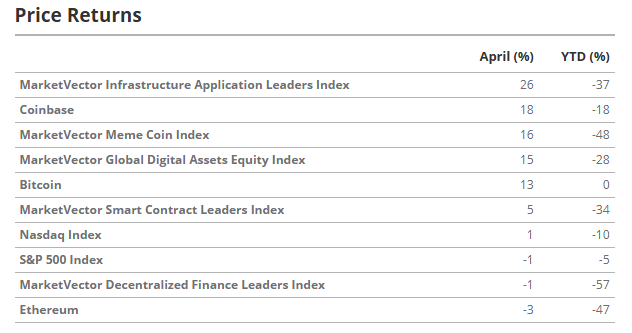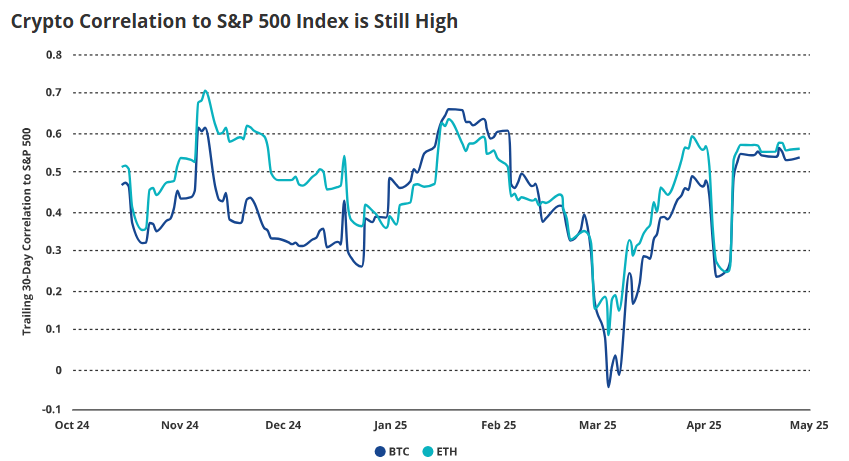-
In April 2025, Bitcoin (BTC) showcased its potential as a macro hedge by briefly outperforming traditional stocks, demonstrating its evolving market dynamics.
-
Corporate accumulation of BTC accelerated, highlighted by significant purchases from notable firms, signaling increasing institutional interest and confidence.
-
While Bitcoin showed resilience, altcoins faced stark declines, indicating a contrasting performance landscape within the crypto sector.
This article explores Bitcoin’s performance amidst market fluctuations in April 2025 and corporate interest, outlining significant developments in the crypto landscape.
Bitcoin Outperforms Stocks During April Market Selloff
Bitcoin’s performance in April was noteworthy as it decoupled from traditional markets, albeit briefly. This moment captured the attention of investors and analysts alike.
“Bitcoin showed signs of decoupling from equities during the week ending April 6,” stated Matthew Sigel, Head of Digital Assets Research at VanEck.

This shift coincided with US President Donald Trump’s announcement of extensive tariff measures, which instigated a global market downturn. While conventional assets like the S&P 500 and gold faced losses, Bitcoin surged from $81,500 to over $84,500, showcasing its potential value amidst market turbulence.
Despite this initial success, Bitcoin’s momentum proved fleeting. As April progressed, the cryptocurrency’s price behavior realigned with equities. VanEck’s report noted that the 30-day correlation between BTC and the S&P 500 briefly dipped below 0.25 but restored to 0.55 by month’s end.
“Bitcoin has not meaningfully decoupled,” underscored the report.

With a 13% monthly gain, Bitcoin outperformed the NASDAQ’s 1% loss and the S&P 500’s flat performance. Additionally, Bitcoin’s volatility decreased by 4%, contrasting with the doubling of equity volatility spurred by escalating geopolitical tensions and trade uncertainties.
As analysts interpret these movements, VanEck identifies early indicators of a structural shift. The report highlights a growing institutional and sovereign interest in Bitcoin as a reliable store-of-value asset.
“Structural tailwinds are forming. Bitcoin continues to find support as a sovereign, uncorrelated asset,” authored Sigel.
VanEck also referenced Venezuela and Russia’s adoption of Bitcoin in international trade as vital signals of this evolving narrative.
Corporate Bitcoin Accumulation Grew In April
Simultaneously, corporate Bitcoin accumulation saw a marked increase in April. Strategy (formerly known as MicroStrategy) prominently acquired 25,400 BTC, supplemented by fresh investments from Metaplanet and Semler Scientific.
Additionally, SoftBank, Tether, and Cantor Fitzgerald announced their joint effort, 21 Capital, aimed at securing $3 billion in Bitcoin.
These moves align with Standard Chartered’s assertion that Bitcoin is establishing itself as a hedge against traditional financial risks, particularly in regard to U.S. Treasury securities.
According to Geoff Kendrick, Head of Digital Asset Research at Standard Chartered, “I think Bitcoin is a hedge against both TradFi and U.S. Treasury risks. The threat to remove U.S. Federal Reserve Chair Jerome Powell falls into Treasury risk—so the hedge is on.”
In contrast to Bitcoin’s resilience, the broader cryptocurrency market faced challenges. Altcoins, particularly speculative meme coins, DeFi tokens, and major platforms like Ethereum and Sui, experienced significant downturns.
The MarketVector Smart Contract Leaders Index fell by 5% in April, now 34% down year-to-date. Nonetheless, Solana distinguished itself with a 16% rise, largely due to network upgrades and revitalized institutional interest.
Sui, meanwhile, achieved a notable 45% increase in daily decentralized exchange volume, ranking among the top 10 in smart contract platform revenue. However, Ethereum lagged with a 3% decline, shrinking its fee revenue share significantly from 74% two years prior to just 14%.
The broader altcoin market displayed bearish tendencies, with speculative energy waning. Trading volumes in meme coins plummeted by 93% from January to March, resulting in a 48% decline in the MarketVector Meme Coin Index year-to-date.
Considering price and volatility metrics, Bitcoin’s relative stability in April might provide insights into its future trajectory. VanEck concludes that, although Bitcoin hasn’t entirely escaped its correlation with risk assets, the groundwork for a long-term diversification may be quietly establishing.
Conclusion
In summary, while Bitcoin demonstrated adaptability and potential as a macro hedge amid market uncertainty, the broader realm of cryptocurrencies continues to grapple with volatility. Investors should monitor these emerging trends, particularly regarding institutional interest, as they may inform future strategies and market dynamics.
